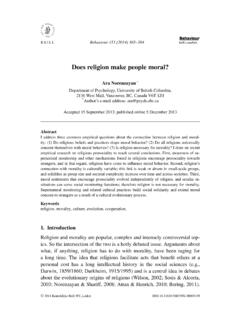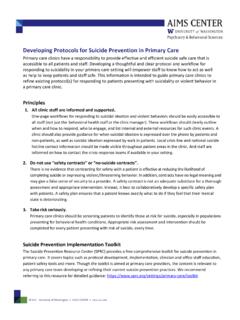Transcription of The Three-Step Theory (3ST): A New Theory of Suicide ...
1 International Journal of Cognitive Therapy, 8(2), 114 129, 2015 2015 International Association for Cognitive Psychotherapy114 Address correspondence to E. David Klonsky, University of British Columbia, Department of Psychology, 2136 West Mall, Vancouver, BC V6T 1Z4, Canada; E-mail: OF SUICIDEKLONSKY AND MAYThe Three-Step Theory (3ST): A New Theory of Suicide Rooted in the Ideation-to-Action FrameworkE. David Klonsky and Alexis M. MayDepartment of Psychology, University of British ColumbiaKlonsky and May (2014) argued that an ideation-to-action framework should guide Suicide Theory , research , and prevention . From this perspective, (a) the de-velopment of Suicide ideation and (b) the progression from ideation to Suicide attempts are distinct processes with distinct explanations. The present article in-troduces a specific Theory of Suicide rooted in the ideation-to-action framework: the Three-Step Theory (3ST).
2 First, the Theory hypothesizes that Suicide ideation results from the combination of pain (usually psychological pain) and hopelessness. Second, among those experiencing both pain and hopelessness, connectedness is a key protective factor against escalating ideation. Third, the Theory views the pro-gression from ideation to attempts as facilitated by dispositional, acquired, and practical contributors to the capacity to attempt Suicide . To examine the Theory , the authors administered self-report measures to 910 adults utilizing Amazon s Mechanical Turk (oversampling for ideation and attempt histories). Results sup-ported the Theory s central tenets. First, an interactive model of pain and hopeless-ness accounted for substantial variance in Suicide ideation. This result replicated in both men and women, and across age groups ( , 18 25, 26 35, and 36 70). Also as predicted, connectedness was most protective against ideation in those high on both pain and hopelessness.
3 Finally, dispositional, acquired, and practical aspects of Suicide capacity each predicted Suicide attempt history over and above current and lifetime suicidal ideation. These initial findings support the 3ST. Implications for Suicide prevention and future research are : hopelessness, ideation, pain, suicideSuicide is a leading cause of death worldwide, killing more than 800,000 people each year (World Health Organization [WHO], 2014a). A much larger number of people make Suicide attempts, with some researchers estimating that approxi-mately 25 attempts occur for every Suicide death (Goldsmith, Pellmar, Kleinman, & Bunney, 2002). An even greater number of people consider Suicide ; a world- Theory OF Suicide 115wide study found that for every person who attempts Suicide , there are two to three who have seriously considered Suicide without attempting it (Nock et al.)
4 , 2008). Given this immense public health problem, Suicide has been the focus of many research and prevention efforts, particularly in the past few decades. Howev-er, despite these efforts, there is no evidence of sustained reductions in Suicide rates (WHO, 2014b). The development of more effective prevention and intervention strategies will very likely require a deeper understanding of the fundamental pro-cesses that cause Suicide ideation, attempts, and THEORIES OF SUICIDEMany theorists have sought to explain Suicide . For example, Shneidman (1985, 1993) explained Suicide as a response to overwhelming pain ( , psychache), Durkheim (1897/1951) emphasized the role of social isolation, Baumeister (1990) described Suicide as an escape from an aversive state of mind, and Beck and Abramson (Abramson et al., 2000; Beck, 1967) highlighted the role of hope-lessness. These theories have been tremendously useful in guiding Suicide research and prevention efforts.
5 At the same time, these theories share a particular feature that may be limiting progress in understanding Suicide : They fail to differenti-ate explanations for suicidal thoughts and suicidal behavior. This distinction is especially important when one considers that most people who develop suicidal ideation never go on to make a Suicide attempt (Klonsky & May, 2014; Nock et al., 2008).A NEW GENERATION OF THEORIES OF SUICIDEA critical advance in Suicide Theory occurred 10 years ago when Thomas Joiner (2005) introduced his Interpersonal Theory of Suicide . Joiner introduced a frame-work by which (a) suicidal ideation and (b) the progression from ideation to attempts were treated as separate processes that come with separate sets of expla-nations and risk factors. Joiner proposed a specific application of the framework: Perceptions of low belongingness and high burdensomeness combine to bring about desire for Suicide , whereas high capability for Suicide facilitates potentially lethal Suicide attempts.
6 However, we believe that the framework itself is at least as important a contribution to the field as the particulars of his Theory . Inspired by Joiner s work, we recently proposed that an ideation-to-action framework should guide all Suicide Theory and research (Klonsky & May, 2014). That is, the (a) development of Suicide ideation and (b) progression from ideation to Suicide attempts should be viewed as distinct processes with distinct view Joiner s Interpersonal Theory as the first ideation-to-action Theory of Suicide , which has likely spawned a new generation of Suicide theories. For example, another recent Theory of Suicide , Rory O Connor s (2011) Integrated Motivational-Volitional model, also proposes separate explanations for suicidal 116 KLONSKY AND MAYideation and Suicide attempts. O Connor suggests that defeat and entrapment are the primary drivers of suicidal ideation, and that acquired capability along with others factors ( , access to lethal means, planning, impulsivity) explain the pro-pensity to act on suicidal thoughts.
7 We find it extremely encouraging that theorists appear to be embracing and utilizing an ideation-to-action PROPOSED Theory OF SUICIDEThe purpose of the present article is to describe and empirically evaluate our own Theory of Suicide positioned within an ideation-to-action framework. Like the the-ories of Joiner and O Connor, our Theory offers separate explanations for (a) the development of suicidal ideation and (b) the progression from suicidal ideation to attempts. The Theory is relatively parsimonious in that Suicide ideation and at-tempts are explained in terms of just four factors: pain, hopelessness, connected-ness, and Suicide capacity. The Theory is illustrated in Figure 1 and explained 1: DEVELOPMENT OF SUICIDAL IDEATION Regarding the development of suicidal ideation, we believe that the first step to-ward ideation begins with pain. Pain usually, but not necessarily, refers to psycho-logical or emotional pain.
8 Fundamentally, people are shaped by behavioral con-ditioning. We perform behaviors that are rewarded and avoid behaviors that are punished. If someone s day-to-day experience of living is characterized by pain, FIGURE 1. Illustration of our proposed Three-Step Theory (3ST) of OF Suicide 117this individual is essentially being punished for living, which may decrease the desire to live and, in turn, initiate thoughts about is intentional that we do not specify the nature of the pain. Just as different sources of punishment can similarly shape behavior ( , electric shock [Alexan-der et al., 1973], loud noises [Watson & Rayner, 1920], noxious odors [Tanner & Zeiler, 1975], social exclusion [Williams, Cheung, & Choi, 2000], or any suf-ficiently aversive stimulus [Mazur, 2012]), we believe that different sources of pain can all lead to a decreased desire to live.
9 These may include physical suffering (Ratcliffe, Enns, Belik, & Sareen, 2008), social isolation (Durkheim, 1897/1951), burdensomeness and low belongingness (Joiner, 2005), defeat and entrapment (O Connor, 2011), negative self-perceptions (Baumeister, 1990), and myriad oth-er aversive thoughts, emotions, sensations, and experiences. The first step toward suicidal ideation begins with pain, regardless of its source. However, pain alone is not sufficient to produce suicidal ideation. If someone living in pain has hope that the situation can improve, the individual likely will focus on obtaining a future with diminished pain rather than on the possibility of ending his or her life. For this reason, hopelessness is also required for the devel-opment of suicidal ideation. From our perspective, when someone s day-to-day experience is characterized by pain, and the person feels hopeless that the pain will improve, he or she will consider Suicide .
10 In short, the combination of pain and hopelessness is what causes Suicide ideation to develop. Our perspective is con-sistent with recent research finding that pain and hopelessness are the two most common motivations for Suicide attempts (May & Klonsky, 2013).Importantly, we believe it is the combination of pain and hopelessness that is required to bring about suicidal ideation. Someone in pain but with hope for a better future will continue to engage with life. Similarly, someone who feels hope-less about the future but without day-to-day pain will not consider Suicide . The latter situation may seem less intuitive than the former, so consider the following example. A young adult recently graduated from university and moved back in with her parents. If this young adult lacks a marketable degree, good grades, and a sense of her career interests, she may very well feel hopeless about the future.














